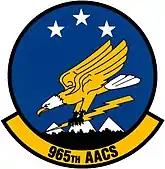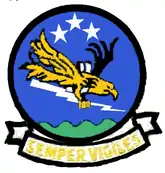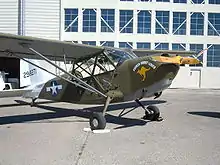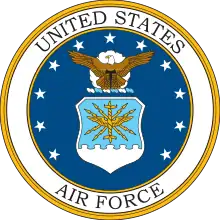965th Airborne Air Control Squadron
The 965th Airborne Air Control Squadron is part of the 552d Air Control Wing at Tinker Air Force Base, Oklahoma. It operates Boeing E-3 Sentry aircraft conducting airborne command and control missions.
| 965th Airborne Air Control Squadron | |
|---|---|
 552d Air Control Wing Boeing E-3 Sentry at Tinker AFB | |
| Active | 1943–1944; 1944–1945; 1955–1971; 1978–present |
| Country | |
| Branch | |
| Role | Airborne Command and Control |
| Part of | Air Combat Command |
| Garrison/HQ | Tinker Air Force Base |
| Motto(s) | Semper Vigiles Latin Always Watchful |
| Engagements | China-Burma-India Theater Desert Storm Global War on Terrorism[1] |
| Decorations | Air Force Outstanding Unit Award with Combat "V" Device Air Force Meritorious Unit Award Air Force Outstanding Unit Award Republic of Vietnam Gallantry Cross with Palm[1] |
| Insignia | |
| 965th Airborne Air Control Squadron emblem (approved 31 January 1979)[1] |  |
| 965th Airborne Early Warning and Control Squadron emblem (approved 4 September 1956)[2] |  |
The first two antecedents of the squadron were active during World War II. The 595th Bombardment Squadron served as an Operational and Replacement Training Unit, before being inactivated in a general reorganization of Army Air Forces training units. The 165th Liaison Squadron performed special operations in India and Burma from September 1944 until the end of the war, when it returned to the United States for inactivation.
The unit's other predecessor unit was activated in 1955 as the 965th Airborne Early Warning and Control Squadron. It performed air defense patrols off the Pacific coast of the United States until inactivating in 1971. It was activated again at Tinker Air Force Base, Oklahoma in 1978 as the 965th Airborne Warning and Control Squadron,
Mission
Provide the combat Air Force with airborne systems and personnel for surveillance, warning and control of strategic, tactical, and special mission forces.[3]
History
Bombardment training

The 595th Bombardment Squadron was first activated at Mountain Home Army Air Field, Idaho on 16 February 1943 as one of the four original squadrons of the 396th Bombardment Group.[1][4] After initial organization and equipping with Boeing B-17 Flying Fortress heavy bombers, the squadron moved to Moses Lake Army Air Base, Washington. There the squadron acted as an Operational Training Unit (OTU) for B-17 units. The OTU program involved the use of an oversized parent unit to provide cadres to "satellite groups"[5] In August 1943, the unit's mission changed to being a Replacement Training Unit (RTU).[1] Like OTUs, RTUs were an oversized units. Their mission, however was to train individual pilots or aircrews.[5]
In November 1943, the 595th moved to Drew Field, Florida, where it would remain for the duration of its active service.[1] However, the Army Air Forces was finding that standard military units, based on relatively inflexible tables of organization were not well adapted to the training mission. Accordingly, it adopted a more functional system in which each base was organized into a separate numbered unit.[6] The 592d was inactivated on 1 May 1944 at Drew Field, Florida.[1] Its personnel and equipment became part of the 326th AAF Base Unit.[7]
Special operations in Burma
.jpg.webp)

The 165th Liaison Squadron was activated at Asansol, India as part of the 1st Air Commando Group in September 1944. It flew evacuation missions and provided light transport services for ground forces in Burma from 6 October 1944 until 23 April 1945. It returned to Asansol that month and remained there until October, when it returned to the United States and was inactivated at the Port of Embarkation.[1]
Air defense patrols

The 965th Airborne Early Warning and Control Squadron was activated in August 1955 as part of the at McClellan Air Force Base, California. It flew long range surveillance, beginning in the late 1950s and rotated aircrews to Southeast Asia from, after about 4 April 1965 until it was inactivated in June 1971.[1]
Airborne warning and control
The 965th was reactivated at Tinker Air Force Base, Oklahoma in 1978 to fly the Boeing E-3 Sentry. The squadron became non-operational the following year, although it remained on the active list. It resumed operations in 1984. The following year, the lineage of the 595th Bombardment Squadron and 165th Liaison Squadron were consolidated with the squadron. It flew combat support missions over Panama from, 20 December 1989 – 24 January 1990 and in Southwest Asia from, 17 January – 6 March 1991.[1]
Operations
- World War II
- Vietnam War
- Operation Just Cause
- Operation Desert Storm
- Operation Iraqi Freedom
- Operation Enduring Freedom[1]
Lineage
- 595th Bombardment Squadron
- Constituted as the 595th Bombardment Squadron (Heavy) on 29 January 1943
- Activated on 16 February 1943
- Inactivated on 1 May 1944
- Consolidated with the 165th Liaison Squadron and the 965th Airborne Warning and Control Squadron as the 965th Airborne Warning and Control Squadron on 19 September 1985[1]
- 165th Liaison Squadron
- Constituted as the 165th Liaison Squadron (Commando) on 9 August 1944
- Activated on 3 September 1944
- Inactivated on 3 Nov 1945
- Consolidated with the 595th Bombardment Squadron and the 965th Airborne Warning and Control Squadron as the 965th Airborne Warning and Control Squadron on 19 September 1985[1]
- 965th Airborne Air Control Squadron
- Constituted as the 965th Airborne Early Warning and Control Squadron on 28 April 1955
- Activated on 8 August 1955
- Inactivated on 30 June 1971
- Redesignated 965th Airborne Warning and Control Squadron on 28 February 1978
- Activated on 1 July 1978
- Consolidated with the 595th Bombardment Squadron and the 165th Liaison Squadron on 19 September 1985
- Redesignated 965th Airborne Air Control Squadron on 1 July 1994[1]
Assignments
- 396th Bombardment Group, 16 February 1943 – 1 May 1944
- 1st Air Commando Group, 3 September 1944 – 3 November 1945
- 552d Airborne Early Warning and Control Wing, 8 August 1955 – 30 June 1971
- 552d Airborne Warning and Control Wing (later 552 Airborne Warning and Control Division, 552 Airborne Warning and Control Wing, 552 Air Control Wing), 1 July 1978
- 552d Operations Group, 29 May 1992 – present[1]
Stations
|
|
Aircraft
- Boeing B-17 Flying Fortress (1943–1944)
- Norduyn C-64 Norseman (1944–1945)
- Stinson L-5 Sentinel (1944–1945)
- Lockheed RC-121 Constellation (1955–1963)
- Lockheed EC-121 Warning Star (1963–1971)
- Boeing E-3 Sentry (1978–1979, 1984–present)[1]
References
- Dollman, TSG David (17 October 2016). "Factsheet 965 Airborne Air Control Squadron". Air Force Historical Research Agency. Retrieved 18 January 2019.
- Endicott, pp. 901-902
- 552 OG Fact Sheet Archived 22 July 2011 at the Wayback Machine
- Maurer, Combat Units, p. 283
- Craven & Cate, Introduction, p. xxxvi
- Goss, p. 75
- See Mueller, p. 351 (simultaneous inactivation of 396th Bombardment Group units and organization of 326th Base Unit).
Bibliography
![]() This article incorporates public domain material from the Air Force Historical Research Agency website http://www.afhra.af.mil/.
This article incorporates public domain material from the Air Force Historical Research Agency website http://www.afhra.af.mil/.
- Craven, Wesley F; Cate, James L, eds. (1955). The Army Air Forces in World War II (PDF). Vol. VI, Men & Planes. Chicago, IL: University of Chicago Press. LCCN 48003657. OCLC 704158. Retrieved 17 December 2016.
- Goss, William A. (1955). "The Organization and its Responsibilities, Chapter 2 The AAF". In Craven, Wesley F.; Cate, James L. (eds.). The Army Air Forces in World War II (PDF). Vol. VI, Men & Planes. Chicago, IL: University of Chicago Press. LCCN 48003657. OCLC 704158. Retrieved 17 December 2016.
- Endicott, Judy G. (1998). Active Air Force Wings as of 1 October 1995 and USAF Active Flying, Space, and Missile Squadrons as of 1 October 1995 (PDF). Air Force History and Museums Program. Washington, DC: Office of Air Force History. ASIN B000113MB2. Retrieved 2 July 2014.
- Maurer, Maurer, ed. (1983) [1961]. Air Force Combat Units of World War II (PDF) (reprint ed.). Washington, DC: Office of Air Force History. ISBN 0-912799-02-1. LCCN 61060979. Retrieved 17 December 2016.
- Maurer, Maurer, ed. (1982) [1969]. Combat Squadrons of the Air Force, World War II (PDF) (reprint ed.). Washington, DC: Office of Air Force History. ISBN 0-405-12194-6. LCCN 70605402. OCLC 72556. Retrieved 17 December 2016.
- Mueller, Robert (1989). Air Force Bases, Vol. I, Active Air Force Bases Within the United States of America on 17 September 1982 (PDF). Washington, DC: Office of Air Force History. ISBN 0-912799-53-6. Retrieved 17 December 2016.
- Ravenstein, Charles A. (1984). Air Force Combat Wings, Lineage & Honors Histories 1947-1977. Washington, DC: Office of Air Force History. ISBN 0-912799-12-9. Retrieved 17 December 2016.

